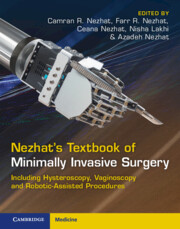 Nezhat's Textbook of Minimally Invasive Surgery
Nezhat's Textbook of Minimally Invasive Surgery Book contents
- Nezhat’s Textbook of Minimally Invasive Surgery
- Nezhat’s Textbook of Minimally Invasive Surgery
- Copyright page
- Dedication
- Contents
- Online Resources
- Contributors
- Foreword
- Preface
- Chapter 1 A History of Modern-Day Video Surgery with and without Robotic Assistance
- Chapter 2 Equipment for Operative Laparoscopy and Hysteroscopy
- Chapter 3 Anesthesia
- Chapter 4 Patient Positioning and Operating Room Setup
- Chapter 5 Laparoscopic Access
- Chapter 6 Laparoscopic Suturing
- Chapter 7 Pelvic Anatomy
- Chapter 8 Hysteroscopy
- Chapter 9 Fertility
- Chapter 10 Management of Adnexal Masses
- Chapter 11 Endometriosis
- Chapter 12 Video Laparoscopic Adhesiolysis and Adhesion Prevention
- Chapter 13 Video Laparoscopic Sterilization
- Chapter 14 Leiomyomas
- Chapter 15 Hysterectomy
- Chapter 16 Pelvic Floor Procedures
- Chapter 17 Video Laparoscopy
- Chapter 18 Gynecologic Malignancy
- Chapter 19 Video Laparoscopic Surgery during Pregnancy
- Chapter 20 Pediatric Surgery
- Chapter 21 Video Laparoscopic Aortic Surgery
- Chapter 22 Additional Procedures for Pelvic Surgeons
- Chapter 23 Simulation Training in Minimally Invasive Surgery
- Chapter 24 Robotic-Assisted Laparoscopy
- Chapter 25 Vascular Surgery and Management of Pelvic Complications
- Chapter 26 Fetal Surgery
- Chapter 27 Hemostatic Agents in Minimally Invasive Surgery
- Chapter 28 New Techniques in Minimally Invasive Surgery
- Book part
- Index
- References
Chapter 5 - Laparoscopic Access
Published online by Cambridge University Press: 06 November 2025
- Nezhat’s Textbook of Minimally Invasive Surgery
- Nezhat’s Textbook of Minimally Invasive Surgery
- Copyright page
- Dedication
- Contents
- Online Resources
- Contributors
- Foreword
- Preface
- Chapter 1 A History of Modern-Day Video Surgery with and without Robotic Assistance
- Chapter 2 Equipment for Operative Laparoscopy and Hysteroscopy
- Chapter 3 Anesthesia
- Chapter 4 Patient Positioning and Operating Room Setup
- Chapter 5 Laparoscopic Access
- Chapter 6 Laparoscopic Suturing
- Chapter 7 Pelvic Anatomy
- Chapter 8 Hysteroscopy
- Chapter 9 Fertility
- Chapter 10 Management of Adnexal Masses
- Chapter 11 Endometriosis
- Chapter 12 Video Laparoscopic Adhesiolysis and Adhesion Prevention
- Chapter 13 Video Laparoscopic Sterilization
- Chapter 14 Leiomyomas
- Chapter 15 Hysterectomy
- Chapter 16 Pelvic Floor Procedures
- Chapter 17 Video Laparoscopy
- Chapter 18 Gynecologic Malignancy
- Chapter 19 Video Laparoscopic Surgery during Pregnancy
- Chapter 20 Pediatric Surgery
- Chapter 21 Video Laparoscopic Aortic Surgery
- Chapter 22 Additional Procedures for Pelvic Surgeons
- Chapter 23 Simulation Training in Minimally Invasive Surgery
- Chapter 24 Robotic-Assisted Laparoscopy
- Chapter 25 Vascular Surgery and Management of Pelvic Complications
- Chapter 26 Fetal Surgery
- Chapter 27 Hemostatic Agents in Minimally Invasive Surgery
- Chapter 28 New Techniques in Minimally Invasive Surgery
- Book part
- Index
- References
Summary
Abdominal laparoscopy was first introduced by Kelling and Jacobaeus in the early 1910s and later by Palmer in the 1950s and 1960s.[1,2] Palmer noted that this new operative technique was superior to culdoscopy as there was a decreased chance of infection, better views of the pelvis, improved access to the pelvic organs and cul-de-sac, and easier application of surgical techniques.
Information
- Type
- Chapter
- Information
- Nezhat's Textbook of Minimally Invasive SurgeryIncluding Hysteroscopy, Vaginoscopy and Robotic-Assisted Procedures, pp. 59 - 74Publisher: Cambridge University PressPrint publication year: 2025
References
References
References
Accessibility standard: WCAG 2.0 A
Why this information is here
This section outlines the accessibility features of this content - including support for screen readers, full keyboard navigation and high-contrast display options. This may not be relevant for you.Accessibility Information
Content Navigation
Allows you to navigate directly to chapters, sections, or non‐text items through a linked table of contents, reducing the need for extensive scrolling.
Provides an interactive index, letting you go straight to where a term or subject appears in the text without manual searching.
Reading Order & Textual Equivalents
You will encounter all content (including footnotes, captions, etc.) in a clear, sequential flow, making it easier to follow with assistive tools like screen readers.
You get concise descriptions (for images, charts, or media clips), ensuring you do not miss crucial information when visual or audio elements are not accessible.
Visual Accessibility
You will still understand key ideas or prompts without relying solely on colour, which is especially helpful if you have colour vision deficiencies.
Structural and Technical Features
You gain clarity from ARIA (Accessible Rich Internet Applications) roles and attributes, as they help assistive technologies interpret how each part of the content functions.